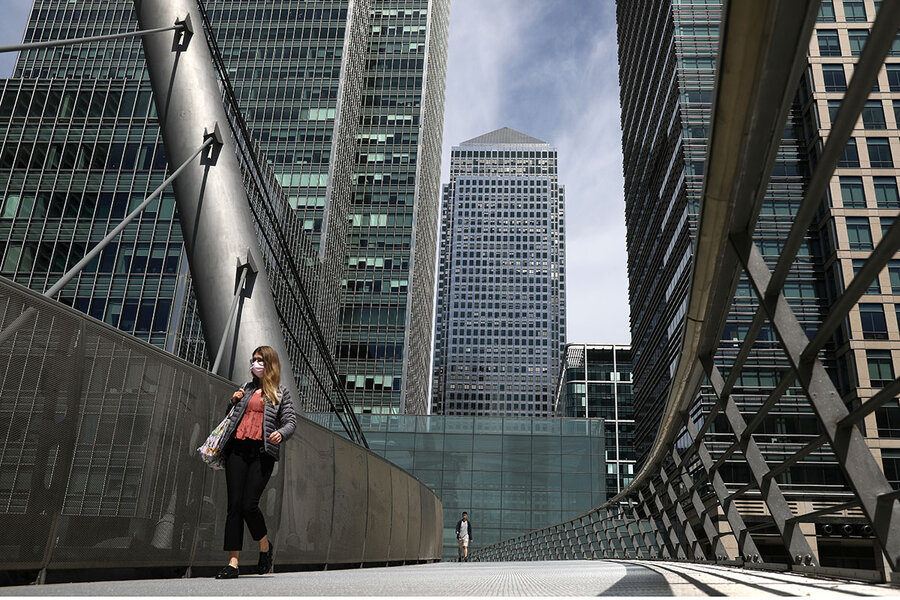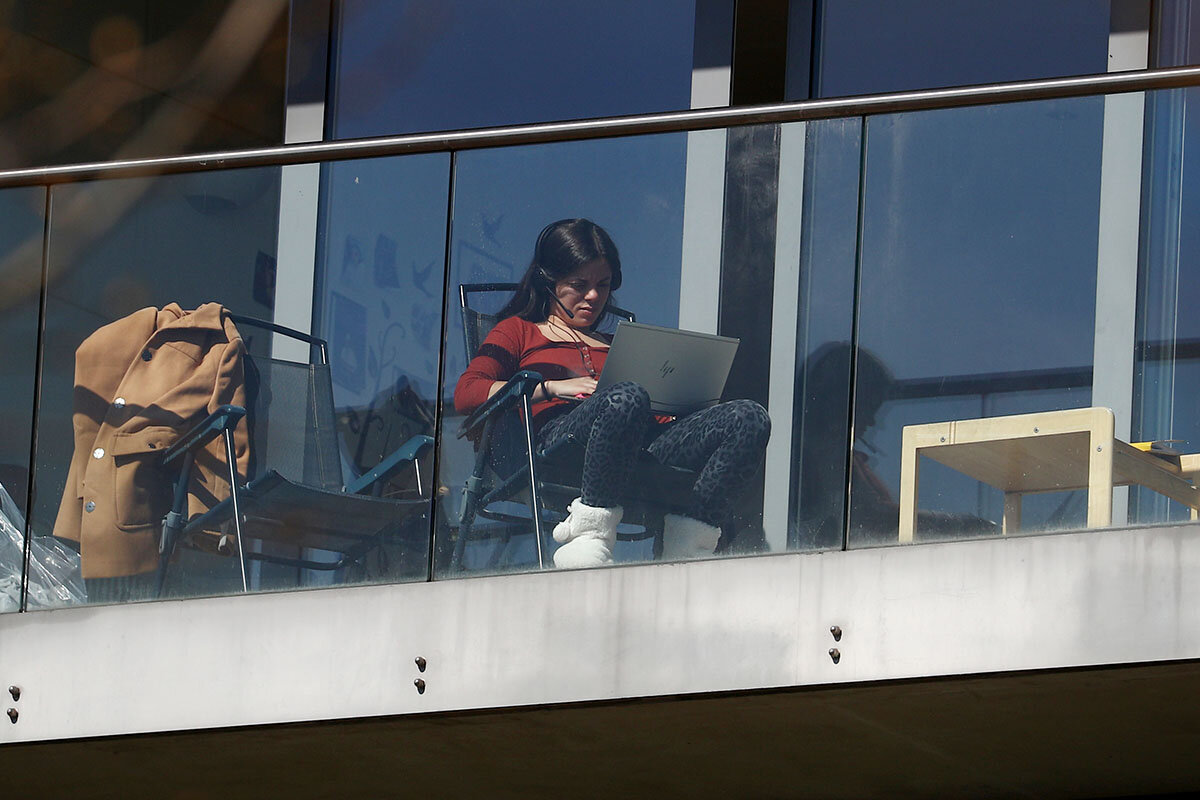Home-work: Not just kids’ stuff
Loading...
| London
A new office building in London is exploring new post-COVID-19 ground. Instead of the standard open-plan design the developer had drawn up, it will be full of individual work pods, each fitted with a desk, video screen, refrigerator, and microwave. And a foldaway bed.
Is this the future of office work? Employees, worried about their health, are still reluctant to go back to their old offices. The work pods would keep them apart from one another.
Why We Wrote This
What will cities feel like when the COVID-19 pandemic is over? Will office workers want to go back to their desks? Or would they rather keep working from home? That would raise all sorts of work-life balance questions.
Many employees around the world say they would be happy to work from home two or three days a week. Employers say their workers are more productive than they used to be.
But that could be because two-thirds of them work weekends when they work from home. The home/work boundary is getting blurred. That is a real problem when you have small kids, or limited space, or both.
And something gets lost when nobody engages in old-fashioned face-to-face conversations anymore. It seems likely that firms and their employees will seek the best of both worlds, splitting their week between home and office.
However much life at home will have changed, there may be life in the old office yet.
It was supposed to be just another glittery new office development in East London’s old docklands. You know the template: clusters of desks laid out in an open plan, an office or two for the execs, another room with a large table for group meetings.
But no longer. Now, the developer is going to fill the space with something dramatically different: thousands of individual “work pods,” each of them 10 square feet, with its own desk, video screen, refrigerator, and microwave. And a foldaway bed.
“Home offices” – like the ones in which hundreds of millions of people in major cities worldwide have been working during the pandemic. Only without the home.
Why We Wrote This
What will cities feel like when the COVID-19 pandemic is over? Will office workers want to go back to their desks? Or would they rather keep working from home? That would raise all sorts of work-life balance questions.
It’s just one example of the profound impact the pandemic is having, not just on governments and national economies, but on working people around the globe. It reflects something else, too: a sense from London to New York and from Sydney to Dubai that some of the changes in how they live and work may be here to stay.
That sense has been growing in recent weeks as governments strive to restart their pandemic-struck economies. In many major cities, where lockdowns meant that all but essential employees were working from home, most businesses have been reluctant to attempt a full-scale move back to the office.
And large numbers of employees are saying they would prefer to keep working from home anyway.
Partly, that’s because they are worried about their health. The East London pod project is an attempt to answer those worries – keeping office workers physically isolated from one another – and similar strategies are being unveiled in other countries.
Many businesses are socially distancing office desks, installing partitions, limiting elevator use, and, of course, upping their cleanliness and disinfection game. Dubai, United Arab Emirates, is looking at its own version of the London developer’s fix: not full-scale “home” pods, but modular enclosures with facial recognition doors, each unit with its own ventilation and air-purification system.
But even when the health dangers of the pandemic fade, it seems that many workers, and many businesses as well, see the advantage of prolonging the new approach to work forced on them by the lockdown. A study this month by the Cigna international health-insurance company surveyed people in 11 countries around the world. Over half the respondents said they would like to work from home for two or three days a week in the future.
If that happens, and the whole concept of office-based work is redefined, the effect on city business districts would be enormous. With far fewer people based in traditional office buildings, the retail businesses serving the people working in them would face a major hit.
But an even greater impact – and adjustment – would involve the millions of people working from home, and their new relationships with the businesses they work for.
This brave new working world – if it’s to prove sustainable – will have to find a whole new definition of work-life balance. So far, the arrangement has been working for many. But some have managed that balance better than others, and it is evident that key issues remain to be resolved.
In the lockdown version of home-work, the distinction between home and work has become blurred.
News reports from around the world in recent weeks have quoted business leaders as saying that most of their employees have been at least as productive as they were in the old office environment. But the Cigna study points to one possible reason why: Nearly 65% of respondents said that they were now working on weekends.
And not all home workers are created equal. For those who have been home-working in single-family homes, the experience has been incomparably easier than it is for those in small apartments, sometimes shared with others. Parents with young children have faced a further range of home-work challenges. Many young singles are finding their new home-based lives to be socially isolated and lonely.
In many traditional office-based businesses, there are formal structures to address issues such as working hours, holiday policies, time off, child care, and the mental-health problems caused by stress and isolation. It’s still far from clear how companies, as well as employment law, would adapt to a widespread, lasting shift to home-working.
Finally, there’s the question of what may be lost in a wholesale move away from the office model. Can Zoom or Skype conversations with colleagues really substitute for water-cooler chats and old-style human interaction? And what about the old assumption that ideas and creativity benefit from the natural, often informal, process of talking to co-workers face to face?
Businesses may be attracted to the idea of home-work. So may many of their employees. But both are already beginning to recognize that indefinite lockdown mode is unsustainable. It may well be that, after a period of experimentation, firms will settle on a mixed approach: Employees will work at home far more than they ever did before the pandemic, but they will go into the office as well a couple of days a week, so as to nurture the human bonds with their co-workers that virtual, dispersed offices cannot sustain.
However much life at home will have changed, there may be life in the old office yet.









